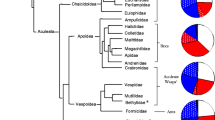Abstract
Numerous recent studies have correlated cuticular hydrocarbon profiles with a wide range of behaviors, particularly in social insects. These findings are wholly or partly based on multivariate statistical methods such as discriminate analysis (DA) or principal component analysis (PCA). However, these methods often provide limited insight into the biological processes that generate the small differences usually detected. This may be a consequence of variability in the system due to inadequate sample sizes and the assumption that all compounds are independent. A fundamental problem is that these methods combine rather than separate the effects of signal components. By using cuticular hydrocarbon data from previous social insect studies, we showed that: (1) in 13 species of Formica ants and seven species of Vespa hornets, at least one group of hydrocarbons in each species was highly (r 2 > 0.8) correlated, indicating that all compounds are not independent; (2) DA was better at group separation that PCA; (3) the relationships between colonies (chemical distance) were unstable and sensitive to variability in the system; and (4) minor compounds had a disproportionately large effect on the analysis. All these factors, along with sample size, need to be considered in the future analysis of complex chemical profiles.



Similar content being viewed by others
References
Aitchison, J. 1986. The Statistical Analysis of Compositional Data. Monographs in Statistics and Applied Probability. Chapman and Hall, London.
Akino, T., Yamamura, K., Wakamura, S., and Yamaoka, R. 2004. Direct behavioural evidence for hydrocarbons as nest mate recognition cues in Formica japonica (Hymenoptera: Formicidae). Appl. Entomol. Zool. 39:381–387.
Bagnéres, A.-G., Riviére, G., and Clément, J.-L. 1998. Artificial neural network modeling of caste odor discrimination based on cuticular hydrocarbons in termites. Chemoecology 8:201–209.
Bartlett, J. E., Kotrlik, J. W., and Higgins, C. C. 2001. Organizational research: Determining appropriate sample size in survey research. Inf. Technol. Learn. Preform. J. 19:43–50.
Chaline, N., Sandoz, J. C., Martin, S. J., Ratnieks, F. L. W., and Jones, G. R. 2005. Learning and discrimination of individual cuticular hydrocarbons by honey bees (Apis mellifera). Chem. Senses 30:327–333.
Dani, F. R., Jones, G. R., Corsi, S., Beard, R., Pradella, D., and Turillazi, S. 2005. Nest mate recognition cues in the honey bee: Differential importance of cuticular alkanes and alkenes. Chem. Senses 30:1–13.
Dapporto, L. 2007. Cuticular lipid diversification in Lasiommata megera and Lasiommata paramegaera: the influence of species, sex, and population (Lepidoptera: Nymphalidae). Bio. J. Linn. Soc. 91:703–710.
Denis, D., Blatrix, R., and Fresneau, D. 2007. How an ant manages to display individual and colonial signals by using the same channel. J. Chem. Ecol. 32:1647–1661.
Field, A. 2005. Discovering Statistics Using SPSS. 2nd edn. Sage, London.
Greene, M. J., and Gordon, D. M. 2003. Cuticular hydrocarbons inform task decisions. Nature 423:32.
Hair, J., Anderson, R., Tatham, R., and Black, W. 1995. Multivariate Data Analysis. 4th edn. Prentice Hall, Upper Saddle River.
Halinski, R., and Feldt, L. S. 1970. The selection of variable in multiple regression analyses. J. Educ. Meas. 7:151–158.
Howard, R. W., and Blomquist, G. J. 2005. Ecological, behavioural and biochemical aspects of insect hydrocarbons. Annu. Rev. Entomol. 50:371–393.
Jackson, D., Martin, S. J., Ratnieks, F. L. W., and Holcombe, M. 2007. Spatial and temporal variation in pheromone composition of ant foraging trails. Behav. Ecol. 18:444–450.
Lavine, B. K., Davidson, C., Vander Meer, R. K., Lahav, S., Soroker, V., and Hefetz, A. 2003. Genetic algorithms for deciphering the complex chemosensory code if social insects. Chemom. Intell. Lab. Syst. 66:51–62.
Lenoir, A., D’ettorre, P., and Errard, C. 2001. Chemical ecology and social parasitism in Ants. Annu. Rev. Entomol. 46:573–599.
Lockey, K. H. 1988. Lipids of the insect cuticle: Origin, composition and function. Comp. Biochem. Physiol. 89B:595–645.
Martin, S. J., and Drijfhout, F. P. 2009. Nest-mate and task cues are influenced and encoded differently within ant cuticular hydrocarbon profiles. J. Chem. Ecol. doi:10.1007/s10886-009-9612-x.
Martin, S. J., Vitikainen, E., Helanterä, H., and Drijfhout, F. P. 2008a. Chemical basis of nest-mate discrimination in the ant Formica exsecta. Proc. R. Soc. Lond. B. 275:1271–1278.
Martin, S. J., Helanterä, H., and Drijfhout, F. P. 2008b. Colony-specific hydrocarbons identify nest mates in two species of Formica ant. J. Chem Ecol. doi:10.1007/s10886-008-9482-7.
Martin, S. J., Helanterä, H., and Drijfhout, F. P. 2008c. Evolution of species-specific cuticular hydrocarbon patterns in Formica ants. Biol. J. Linn. Soc. 95:131–140.
Martin, S. J., Takahashi, J., Ono, M., and Drijfhout, F. P. 2008d. Is the social parasite Vespa dybowskii using chemical transparency to get her eggs accepted? J. Ins. Phys. 54:700–707.
Miller, D. E., and Kunce, J. T. 1973. Prediction and statistical overkill revisited. Meas. Eval. Guid. 6:157–163.
Morgan, E. D. 2004. Biosynthesis in insects, p. 199. Royal Society of Chemistry, Cambridge.
Reyment, R. A. 1989. Compositional data analysis. Terra Rev. 1:29–345.
Sanguinetti, G. 2008. Dimensionality reduction of clustered data sets. IEEE Trans. Pattern Anal. Mach Intell. 30:535–540.
Steiner, F. M., Schlick-Steiner, B. C., Nikiforov, A., Kalb, R., and Mistrik, R. 2002. Cuticular hydrocarbons of Tetramorium ants from Central Europe: Analysis of GC-MS data with self-organizing maps (SOM) and implications for systematics. J. Chem. Ecol. 28:2569–2584.
Steiner, S., Mumm, R., and Ruther, J. 2007. Courtship pheromones in parasitic wasps: comparison of bioactive and inactive hydrocarbon profiles by multivariate statistical methods. J. Chem. Ecol. 33:825–838.
Acknowledgements
Thanks go to Duncan Jackson, Nick Fieller, Guido Sanguinetti, and Kosta Triantafyllopoulos of Sheffield University Maths and Computer Science departments for valuable discussions and comments. Funding was provided by NERC (NE/C512310/1).
Author information
Authors and Affiliations
Corresponding author
Rights and permissions
About this article
Cite this article
Martin, S.J., Drijfhout, F.P. How Reliable is the Analysis of Complex Cuticular Hydrocarbon Profiles by Multivariate Statistical Methods?. J Chem Ecol 35, 375–382 (2009). https://doi.org/10.1007/s10886-009-9610-z
Received:
Revised:
Accepted:
Published:
Issue Date:
DOI: https://doi.org/10.1007/s10886-009-9610-z




